社区中的公共艺术 | 徐渭艺术馆 / ACRC
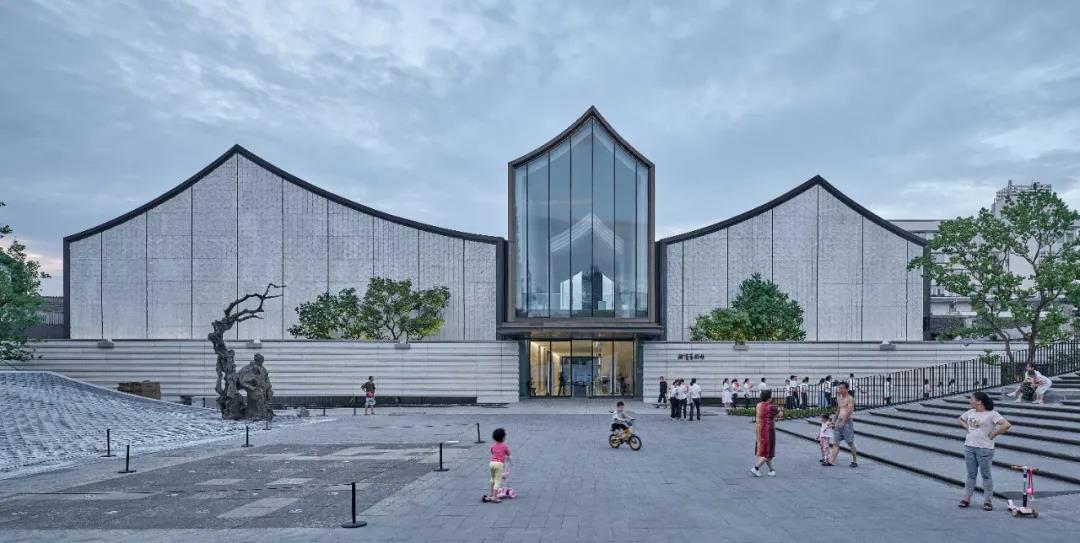
徐渭艺术馆主(南)立面与青藤广场©雷坛坛Main (south) facade of Xu Wei Art Museum and Qingteng Square, by Lei Tantan
徐渭艺术馆及青藤广场,是我们在绍兴古城实践项目里非常重要的一环,也是“又见青藤”城市更新计划中的关键行动,它作为“徐渭诞辰500周年暨徐渭故里开放仪式”举办的主要场馆,于2021年五月正式投入使用。
Xu Wei Art Museum and Qingteng Square are a very important part of our practice project in Shaoxing Ancient City, and also a key action in the urban renewal plan of "Seeing Qingteng Again". As the main venue for the "500th Anniversary of Xu Wei's Birth and the Opening Ceremony of Xu Wei's Hometown", they were officially put into use in May 2021.
事实上,艺术馆的概念方案在首次场地踏勘中已初步成型,方案吸取青藤书屋建屋造园之精髓,并对当下古城更新中的地标式公共文化建筑提出思考:我们尝试建立一种新的空间表达,以此联结以传统民居小尺度为主的周边建成环境,同时满足当代艺术展览对大空间的需求;并借此探讨“历史语境中的现代性”话题。
In fact, the conceptual scheme of the Art Museum has taken shape in the first site survey, which absorbs the essence of Qingteng Bookstore's building and gardening, and puts forward some thoughts on the landmark public cultural buildings in the current renewal of ancient city: we try to establish a kind of new spatial expression, with a view to connecting the surrounding built environment mainly based on the small scale of traditional dwellings, meeting the demands of contemporary art exhibitions for large space, and meanwhile discussing the topic of "modernity in historical context".
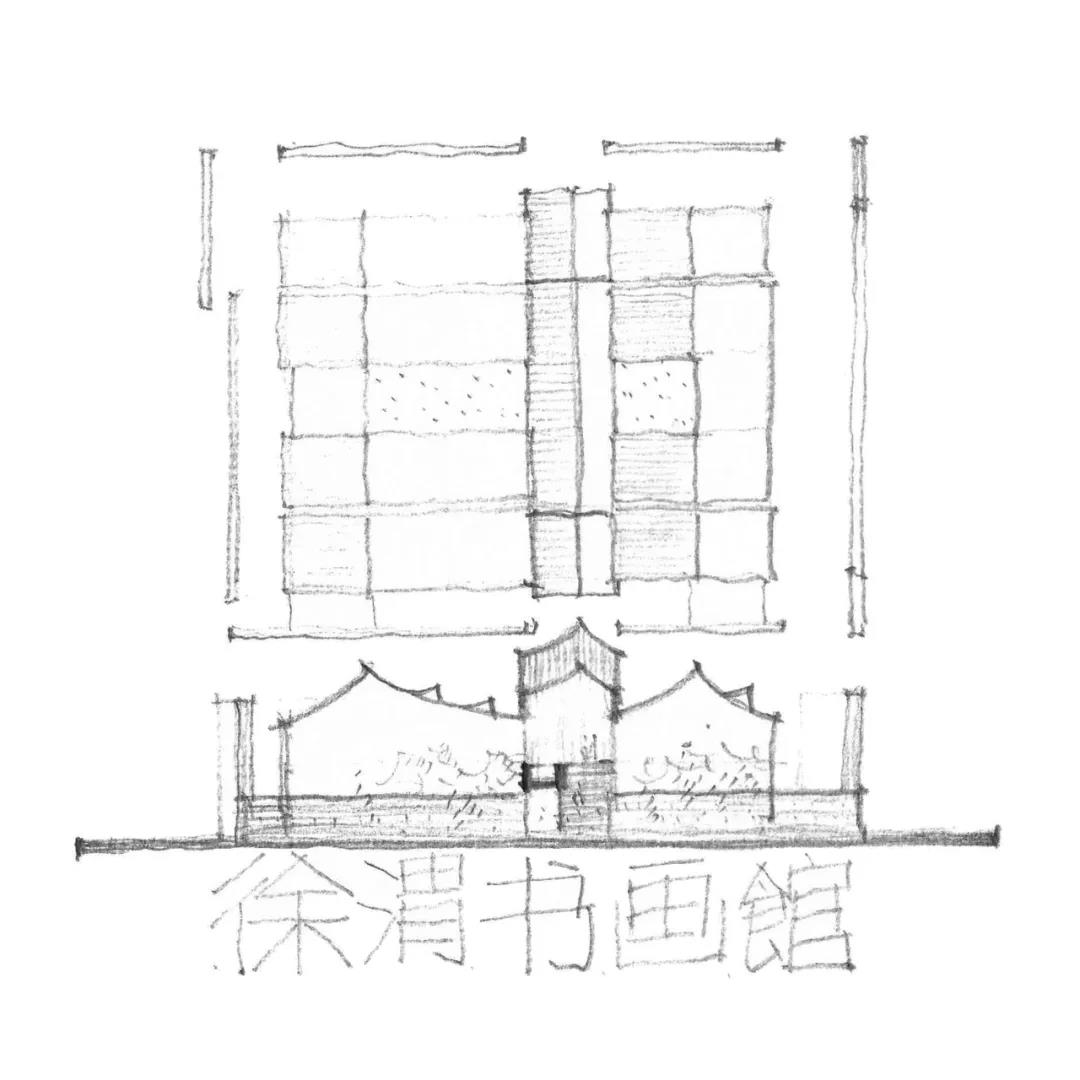
设计草图©胡慧峰
Design sketch, by Hu Huifeng
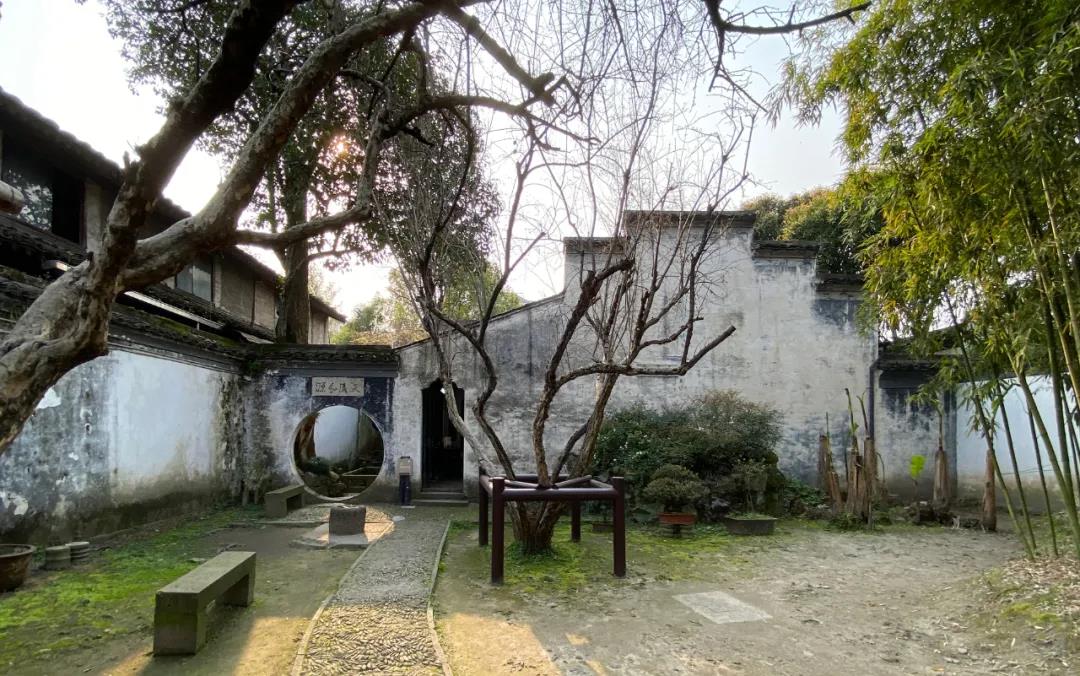
徐渭故居青藤书屋,不大不小、精致优雅、不羁构图、文气十足©ACRC
Qingteng Bookstore, the former residence of Xu Wei, modest, exquisite, elegant, unruly in composition and full of literary flavor, by ACRC
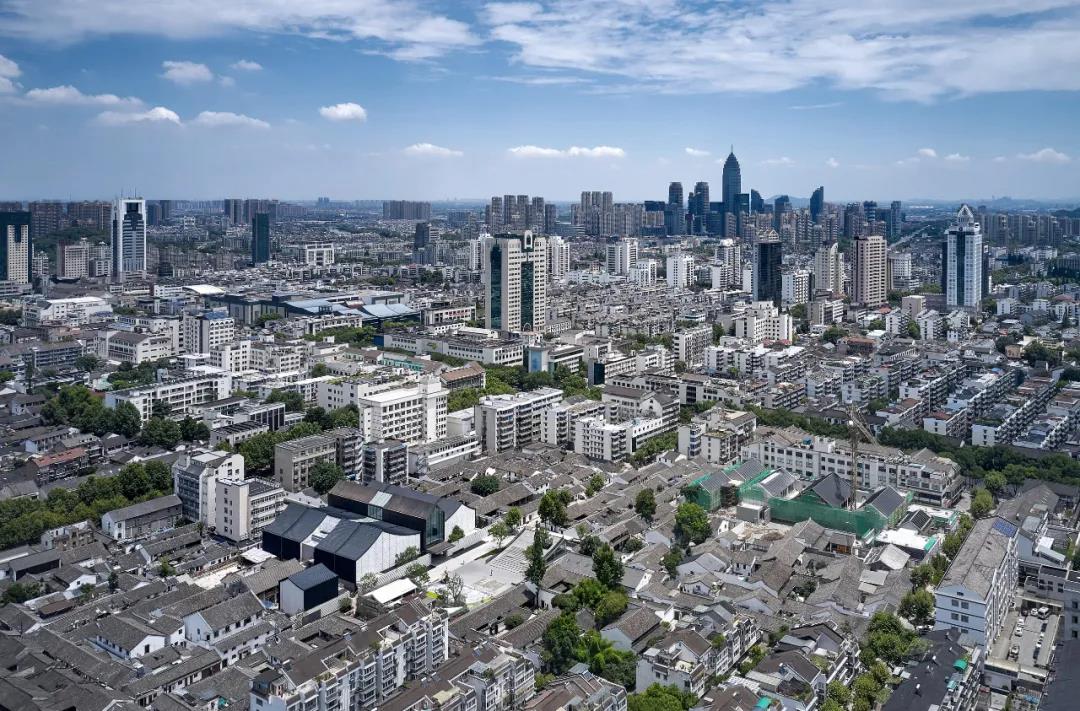
俯瞰徐渭艺术馆,可清晰感知周边小尺度传统民居的建筑肌理©雷坛坛
Overlooking Xu Wei Art Museum, you can clearly perceive architectural texture of the surrounding small-scale traditional dwellings, by Lei Tantan
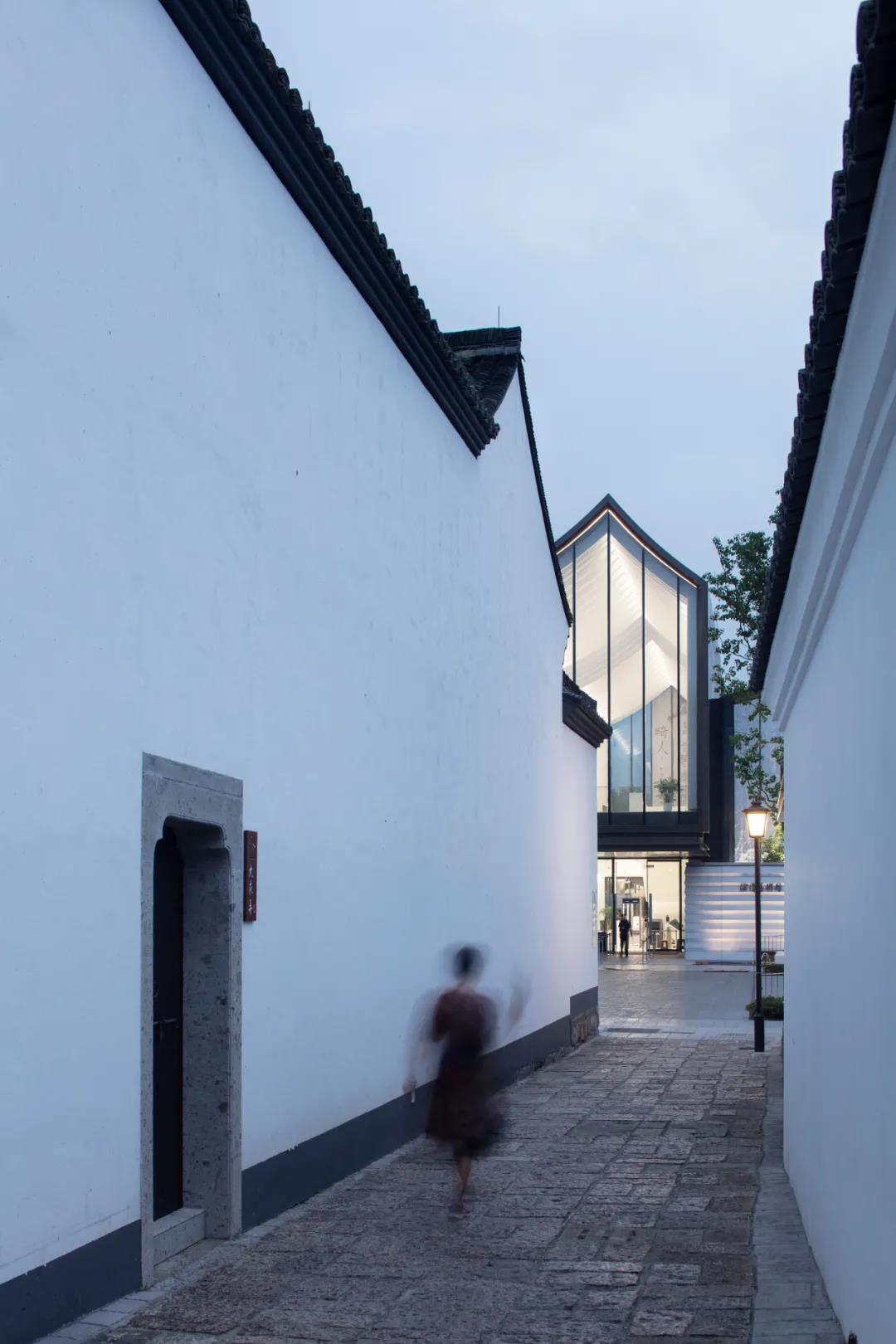
站在大乘弄北端,由青藤书屋方向注视徐渭艺术馆©贾方
Standing at the northern end of Dacheng Lane, and looking at Xu Wei Art Museum from the direction of Qingteng Bookstore, by Jia Fang
纵向五进与开口造园
Longitudinal five-entry and open gardening
Xu Wei Art Museum is located in the former Shaoxing Machine Tool Plant, north of Qingteng Bookstore, the former residence of Xu Wei, and in the middle of Houguan Lane. First of all, we get inspiration from the large space combination of the old Machine Tool Plant, and adopt the construction logic of "longitudinal five-entry, and horizontal three-fold unequal herringbone slope modeling". The two five-entry floors on the east and west sides serve as the main exhibition space; the middle floor spans two floors, opening up the longitudinal five-entry pattern; and the ground floor is a foyer running through the north and south, while the shared hall and small temporary lecture hall are located on the second floor. The shared space on the upper and lower floors also serves as a transfer hub between exhibition halls on both sides.
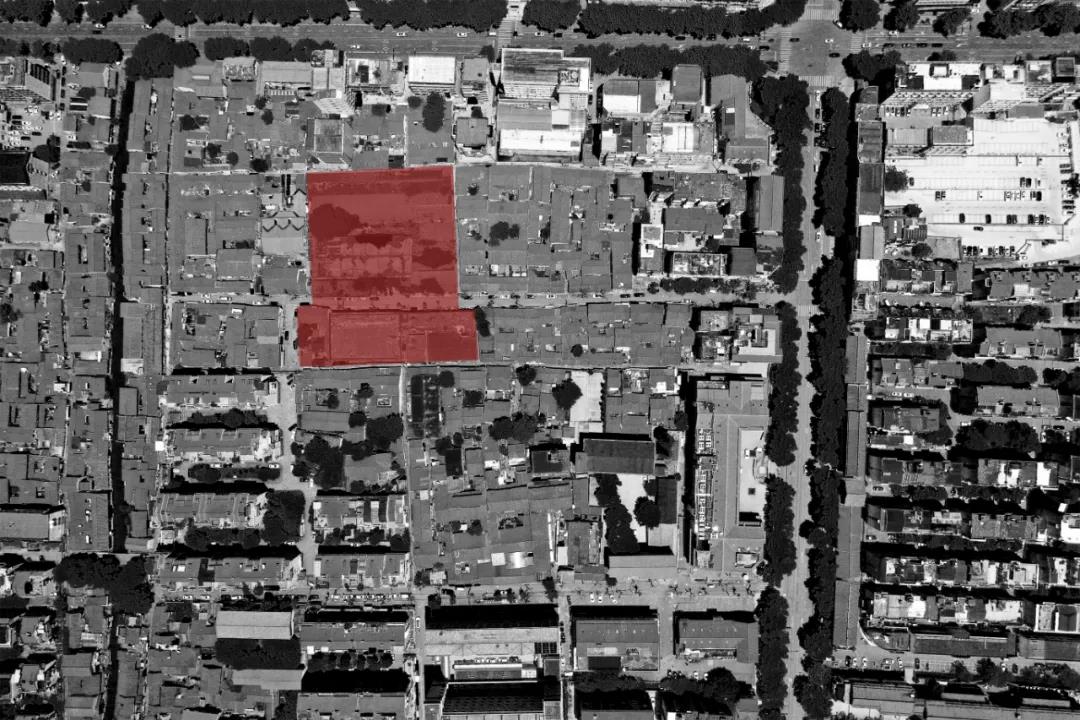
场地区位图©ACRC
Site location map, by ACRC

横向三折的不等边人字坡造型缓和大尺度空间自身的疏离感©章晨帆
Horizontal three-fold unequal herringbone slope modeling alleviates the alienation of large-scale space itself, by Zhang Chenfan
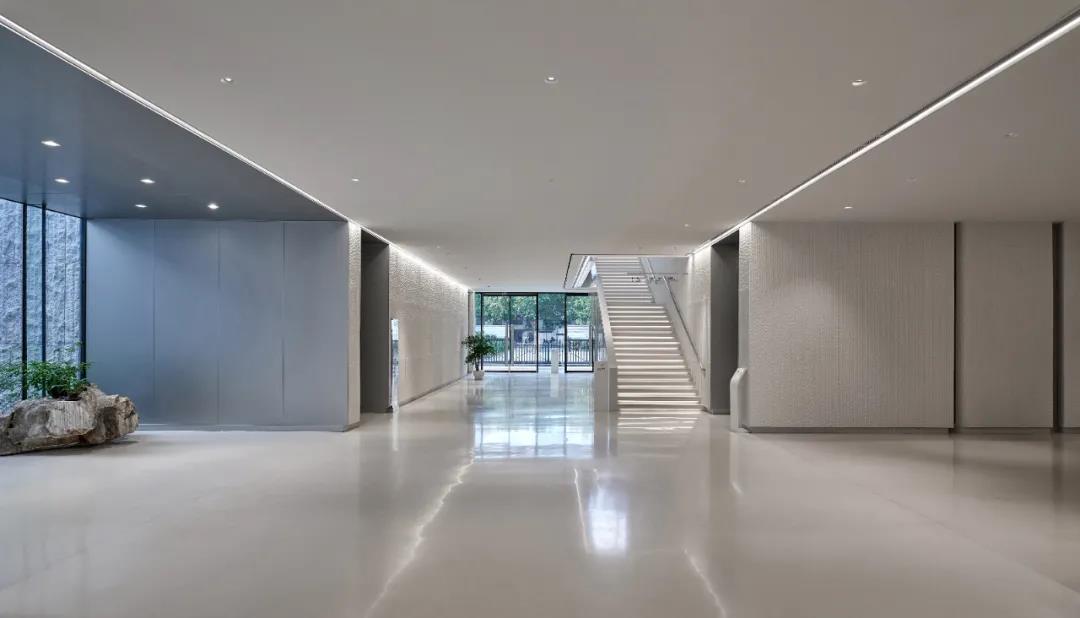
通透的底层贯穿空间,串联两侧展厅与辅助功能,同时连接南北广场©雷坛坛
The transparent ground floor runs through the space, connecting exhibition halls and auxiliary functions on both sides in series, and linking the north and south squares simultaneously, by Lei Tantan

二层中庭提供休憩、集会、观赏、拍照等多重使用场景©雷坛坛
The atrium on the second floor provides multiple use scenarios such as rest, assembly, viewing and photographing, by Lei Tantan
我们在东西两侧的不同平层中各设置一个内部庭院,它们合理分隔了展厅的空间体量,增强室内通透性的同时,山石水瀑在绿意笼罩中的造园设计,也为游客提供了参展之外更多观赏与休闲的可能性。
We set up an internal courtyard in different flat floors on the east and west sides, which reasonably separates the space volume of the exhibition hall and enhances the indoor permeability. And meanwhile, the gardening design of rocks and waterfalls shrouded in greenery also provides visitors with more possibilities for viewing and leisure besides participating in the exhibition.
一层西向主景庭院以观赏为主©雷坛坛
The west-facing main courtyard on the first floor is mainly for viewing, by Lei Tantan
二层东侧庭院为报告厅提供室外休闲场所©雷坛坛
The courtyard on the east side of the second floor provides an outdoor leisure place for the lecture hall, by Lei Tantan
平日里的报告厅也是参观者的空间取景器©贾方
Another function of the temporary lecture hall is to serve as a space viewfinder for visitors, by Jia Fang
乌片如墨与顶地同泼 Black slices and top-ground consistency
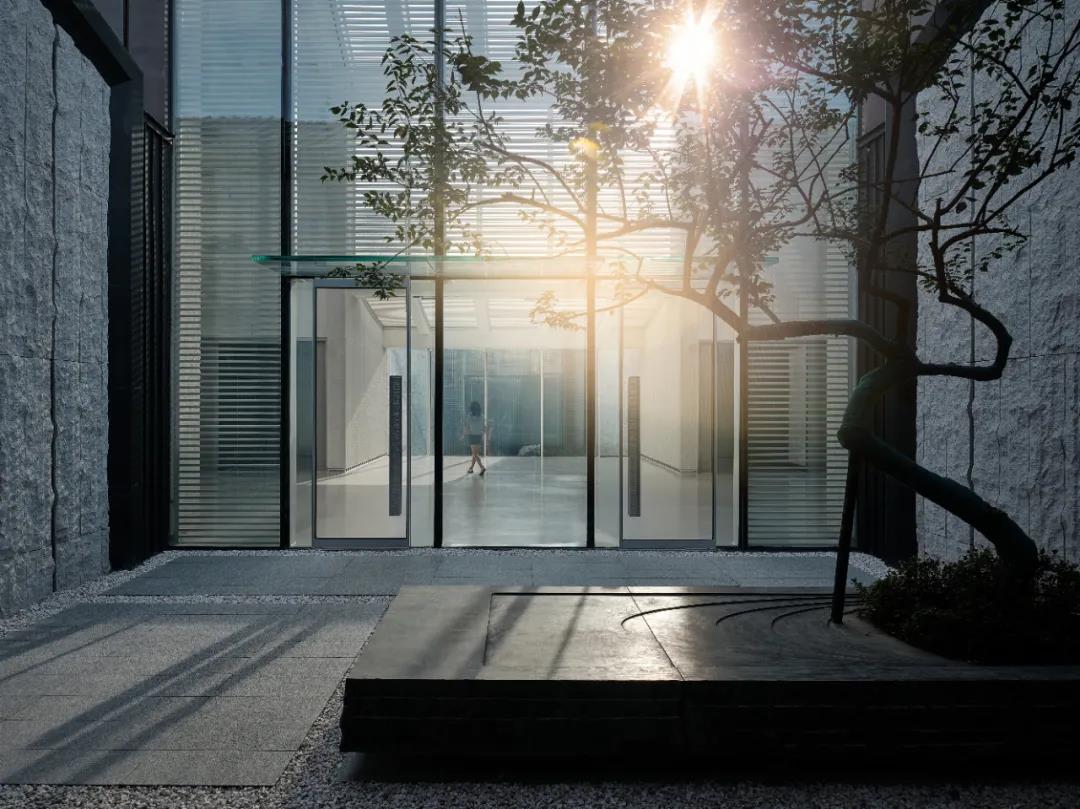

除了空间处理手段,绍兴传统风貌的当代意向表达也体现在对材料的精细选择上:黑色金属肌理自屋顶沿人字坡屋展开,至东西两侧二层结束,南北向二层以上选取白色花岗岩实墙面;一层四面内凹做横向人字坡单元化肌理重复铺贴,局部按功能和统一模数做幕墙处理,并以灰色统一花岗岩和幕墙材质。建筑整体呈现绍兴典型的黑白灰色调,局部留白加之正向三折人字坡轮廓线,共同营造当代山水意向。Besides spatial treatment means, the contemporary intention expression of Shaoxing's traditional style is also reflected in the fine selection of materials: the black metal texture unfolds from the roof along the herringbone slope house to the end of the second floor on the east and west sides, and the white granite solid walls are selected for above the second floor in the north-south direction; the first floor is concave on four sides for repeated pavement of the unitized texture of transverse herringbone slope, the curtain wall is treated locally according to function and unified modulus, and the gray granite and curtain wall materials are unified. The building presents typical black, white and gray tones in Shaoxing as a whole, with local blank space and positive three-fold herringbone slope contour line, which together create the contemporary landscape intention.
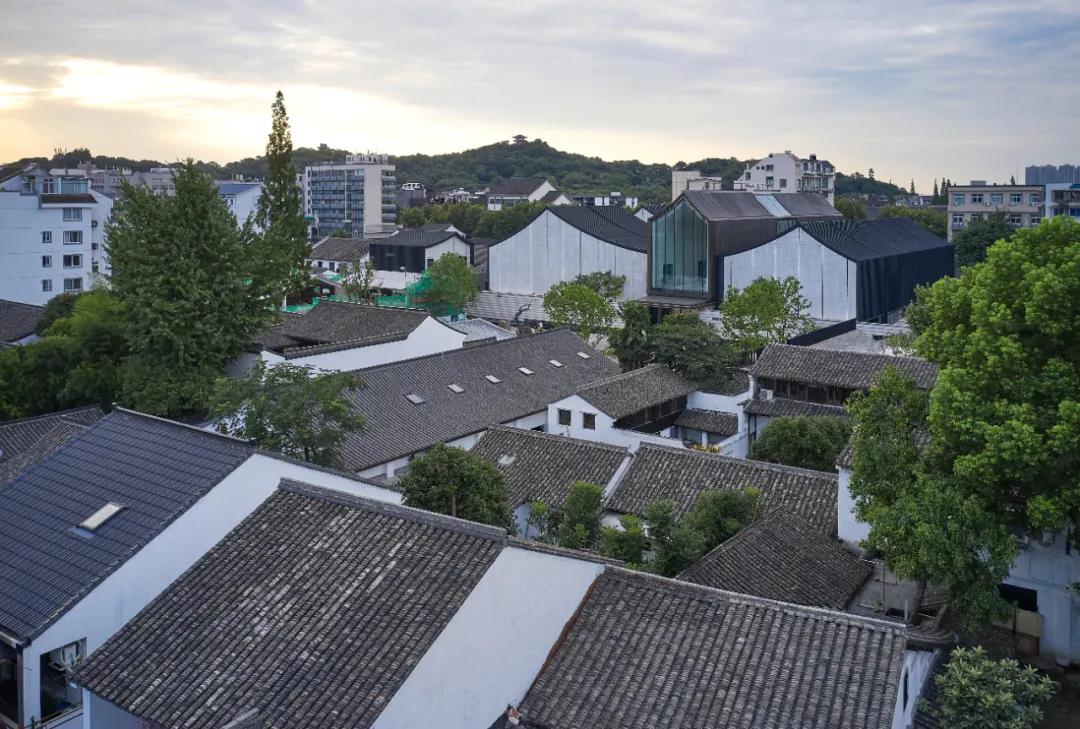
Black, white and gray tones make Xu Wei Art Museum skillfully integrate into the surrounding built environment, by Lei Tantan
被保留的机床厂老墙(施工中拍摄)©ACRC
Old wall of the Machine Tool Plant preserved (photographed during construction), by ACRC
老墙与民居的对景中,可以看到下沉的青藤广场(游客中心)©雷坛坛
In the opposite view of the old wall and the residential buildings, you can see the sunkenQingteng Square (The Visitor Center), by Lei Tantan
在广场的东西两侧分别“掀起”一大一小两处人字坡地景©雷坛坛
Two herringbone slopes, one big and one small, are "lifted up" on the east and west sides of the Square, by Lei Tantan
游客中心躲在人字坡地景之下©雷坛坛
The Visitor Center hides under the herringbone slope view, by Lei Tantan





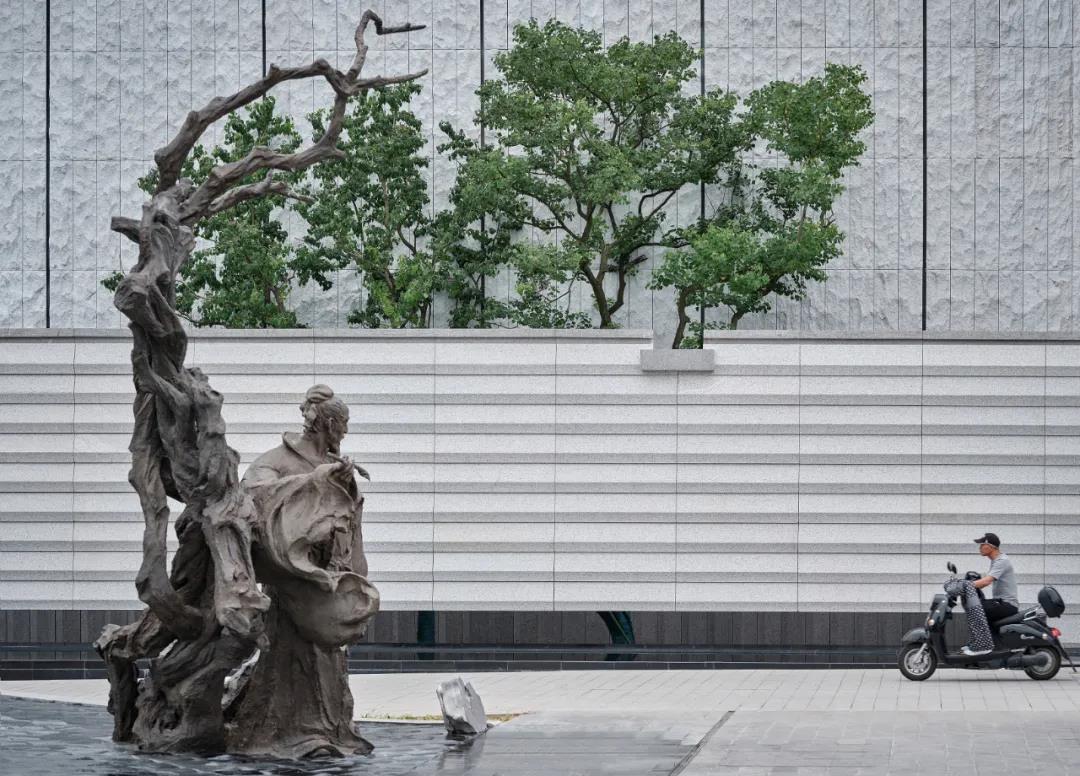
徐渭像伫立在艺术馆西南侧©雷坛坛
Xu Wei Statue stands on the southwest side of the Art Museum, by Lei Tantan
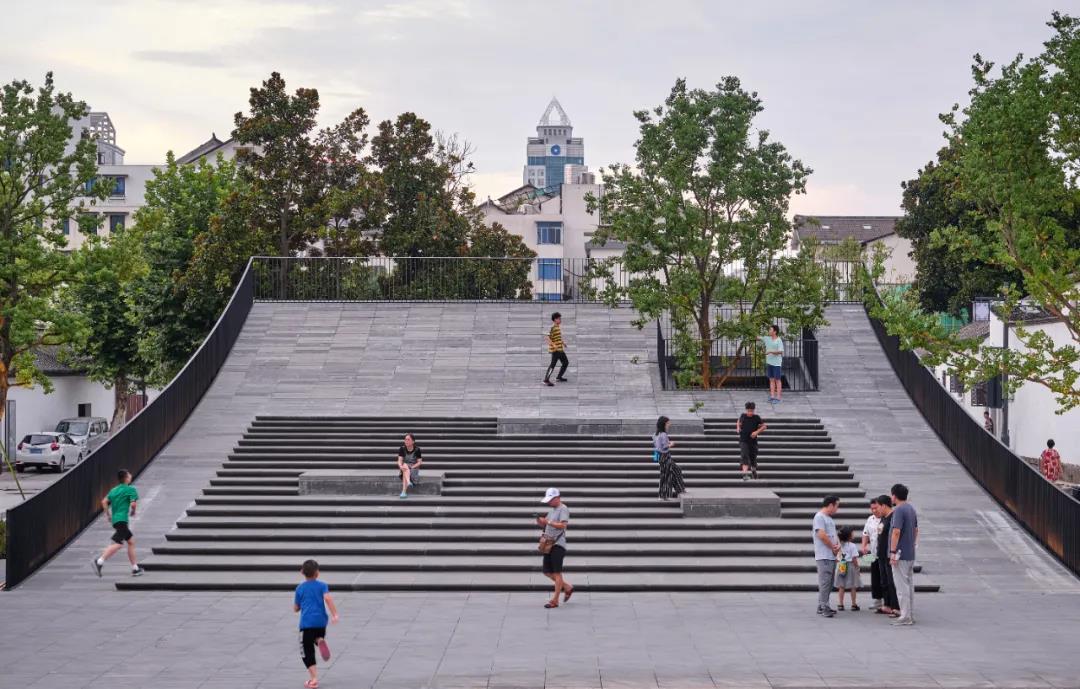
The rising gentle slope sets up drama stage of the City, by Lei Tantan
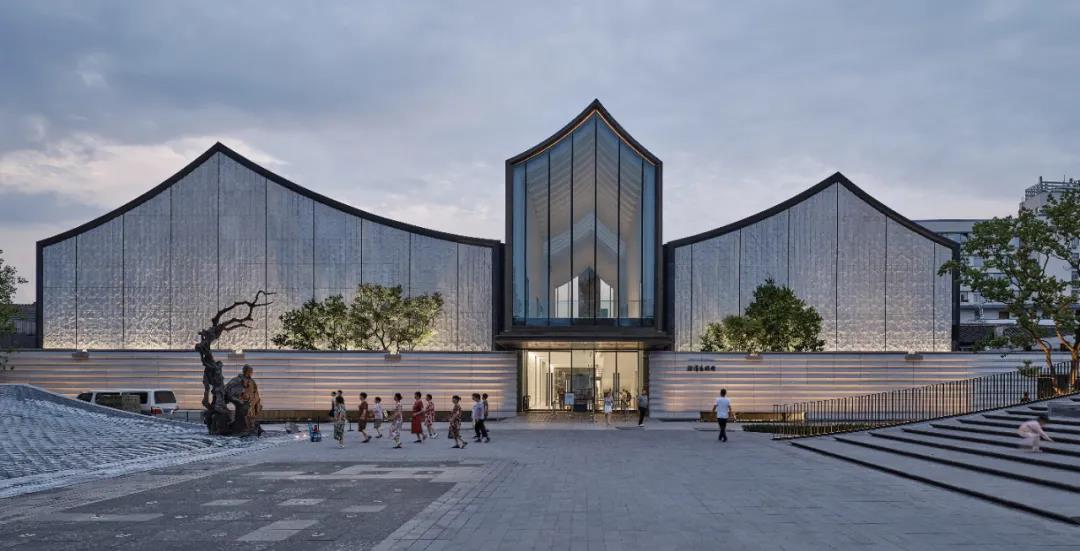
黄昏中的徐渭艺术馆©雷坛坛
Xu Wei Art Museum at dusk, by Lei Tantan
社区里的公共艺术空间
Public Art Space in Community
当城市更新与古城保护日渐成为人们茶余饭后的闲谈话题,我们希望通过设计呈现思考:当代公共艺术空间如何介入古城文化脉络,融入并影响市民生活进而完成对“未来传统社区”的初期重构与展望,提升片区生活空间质量并赋予其新的活力,掀角屋顶,又见青藤。
When urban renewal and ancient city protection are increasingly becoming gossip topics after meals, we hope to present our thinking through design: how the contemporary public art space intervenes in the cultural context of ancient city, integrates into and influences the lives of citizens, and then completes the initial reconstruction and prospect of the "future traditional community", improves the quality of living space in the area and gives it new vitality.
青藤片区更新计划©ACRC
Renewal plan of Qingteng Area, by ACRC
青藤片区更新计划©ACRC
Renewal plan of Qingteng Area, by ACRC
二层南北向幕墙设计连通古城肌理,让变化中的城市面貌成为新的展陈内容©蒋兰兰
The north-south curtain wall design of the second floor connects the texture of the ancient city, making the changing city appearance a new exhibition content, by Jiang Lanlan
徐渭艺术馆正在逐渐融入当地的社区生活之中©雷坛坛
Xu Wei Art Museum is gradually integrating into local community life, by Lei Tantan
参观者排队进入徐渭艺术馆©雷坛坛
Visitors line up to enter Xu Wei Art Museum, by Lei Tantan
青藤广场上的水景观©雷坛坛
Water landscape on Qingteng Square, by Lei Tantan
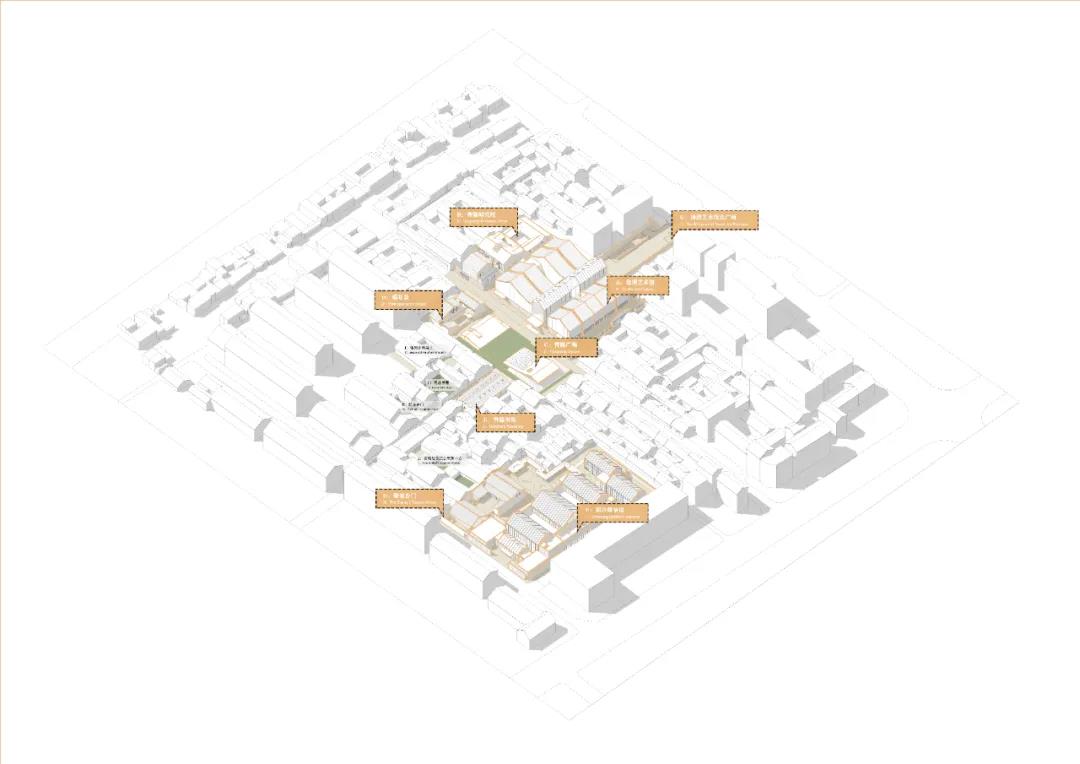
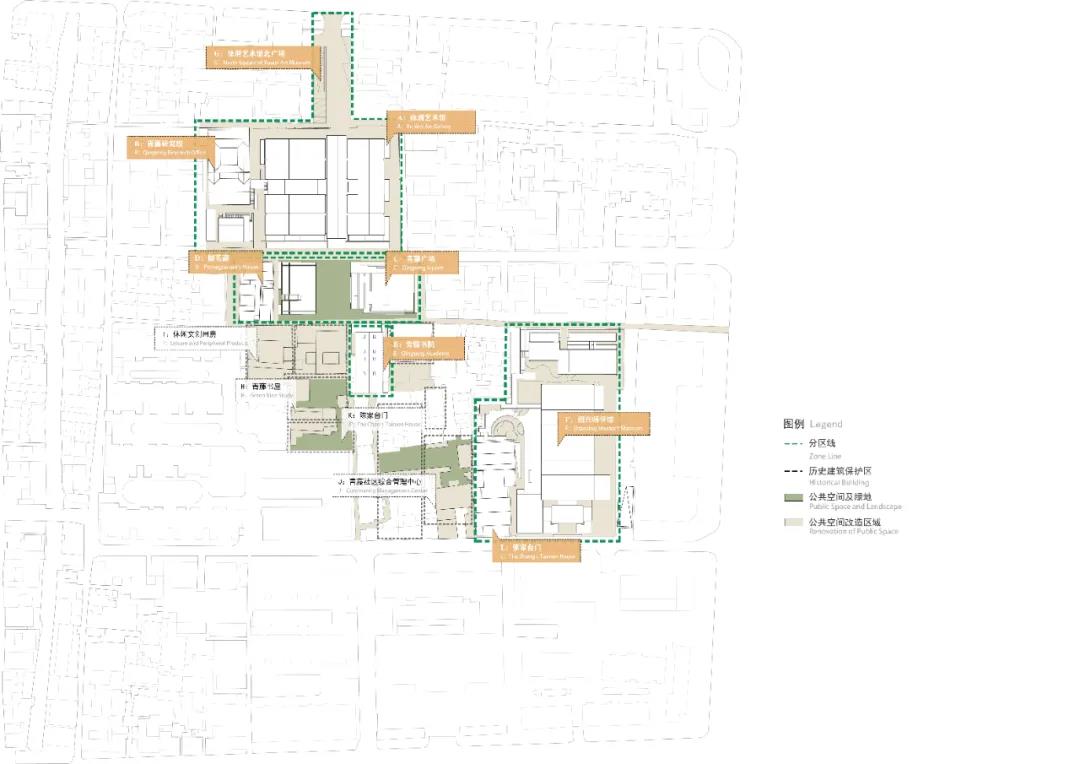
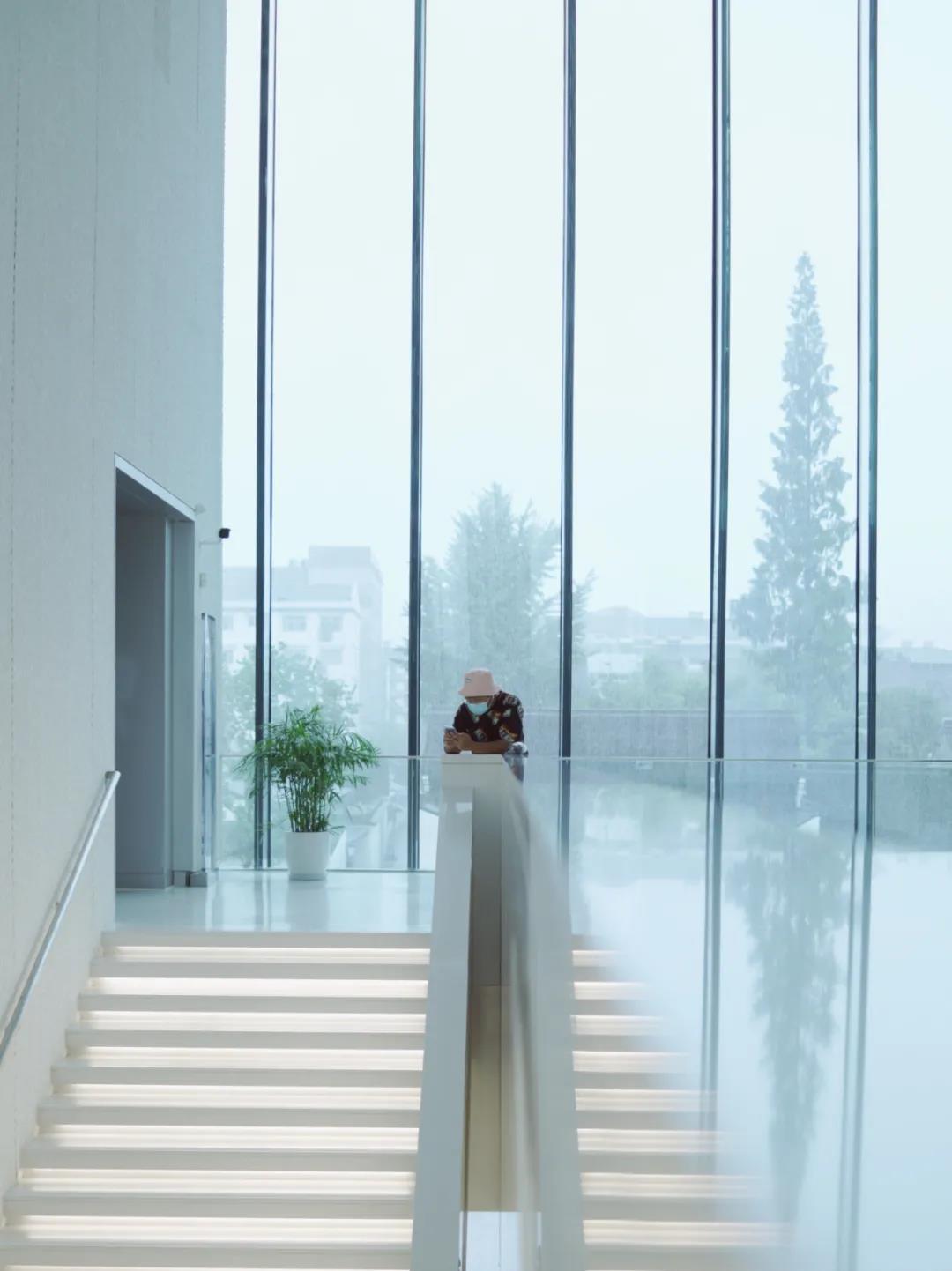

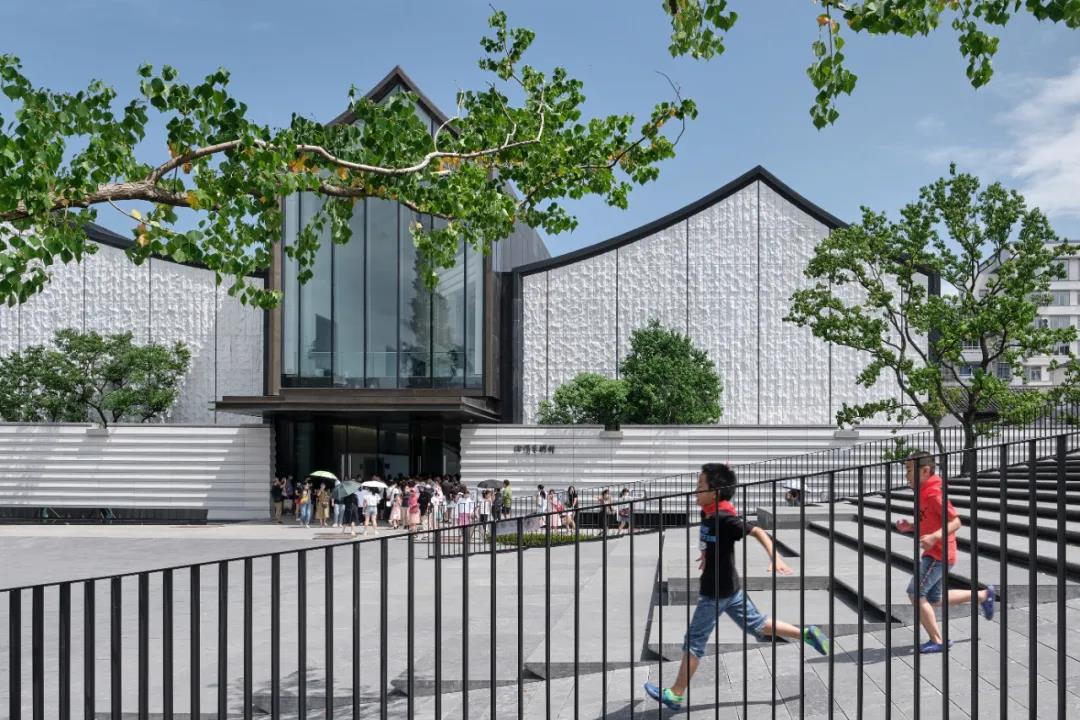
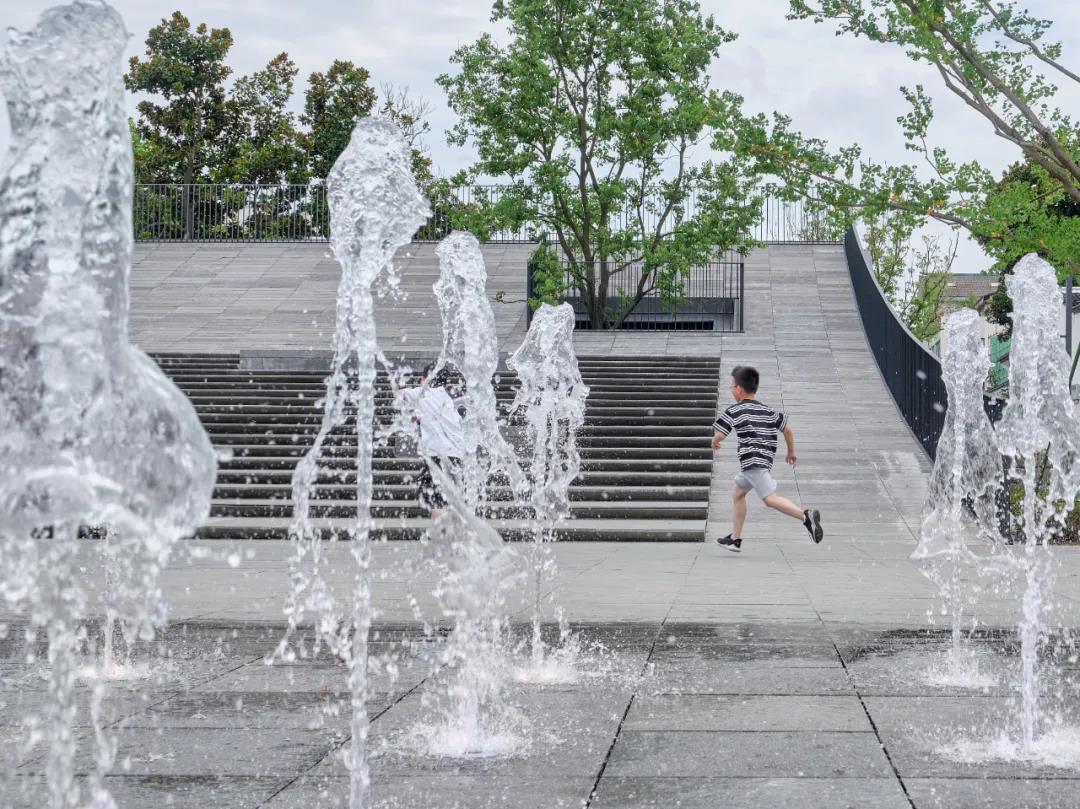
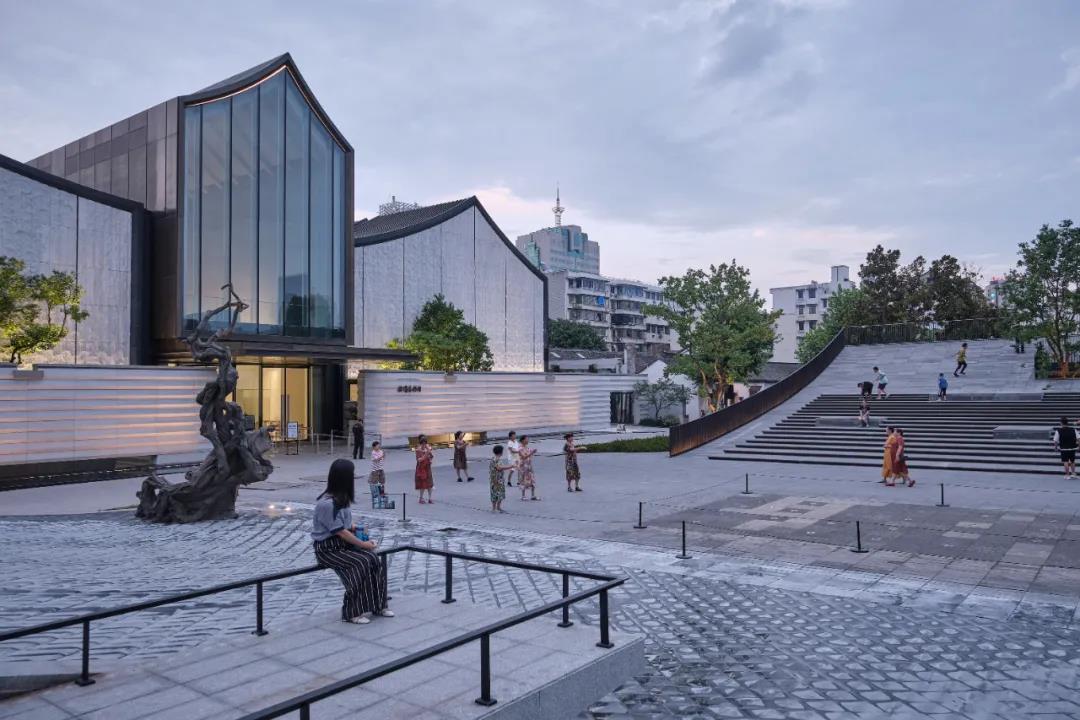
青藤广场建成后的使用情况©雷坛坛
Usage of Qingteng Square after its completion, by Lei Tantan

夜色中的徐渭艺术馆©雷坛坛
Xu Wei Art Museum in the night, by Lei Tantan
设计图纸
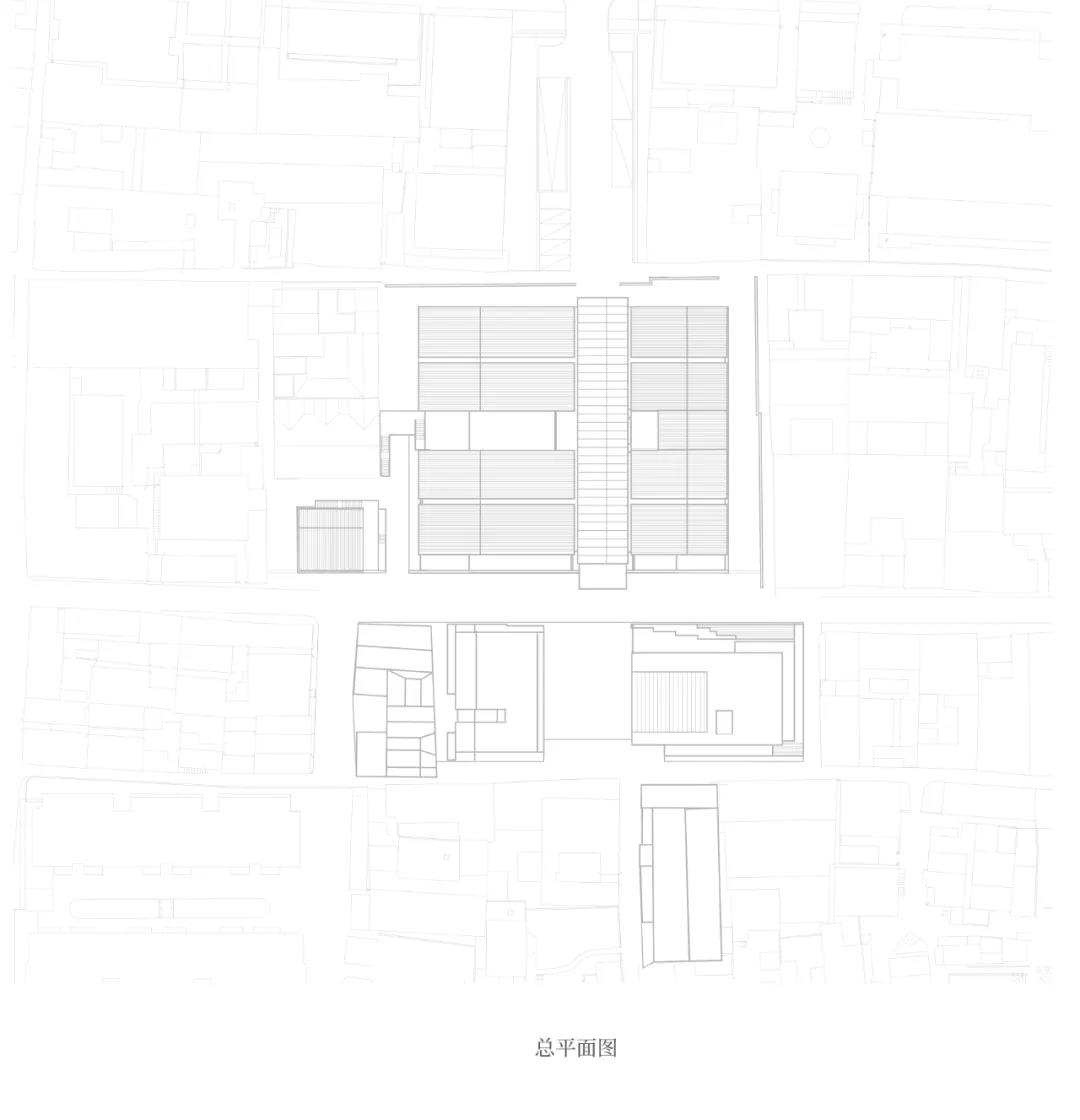
总图线稿
Site Plan (Line Draft)
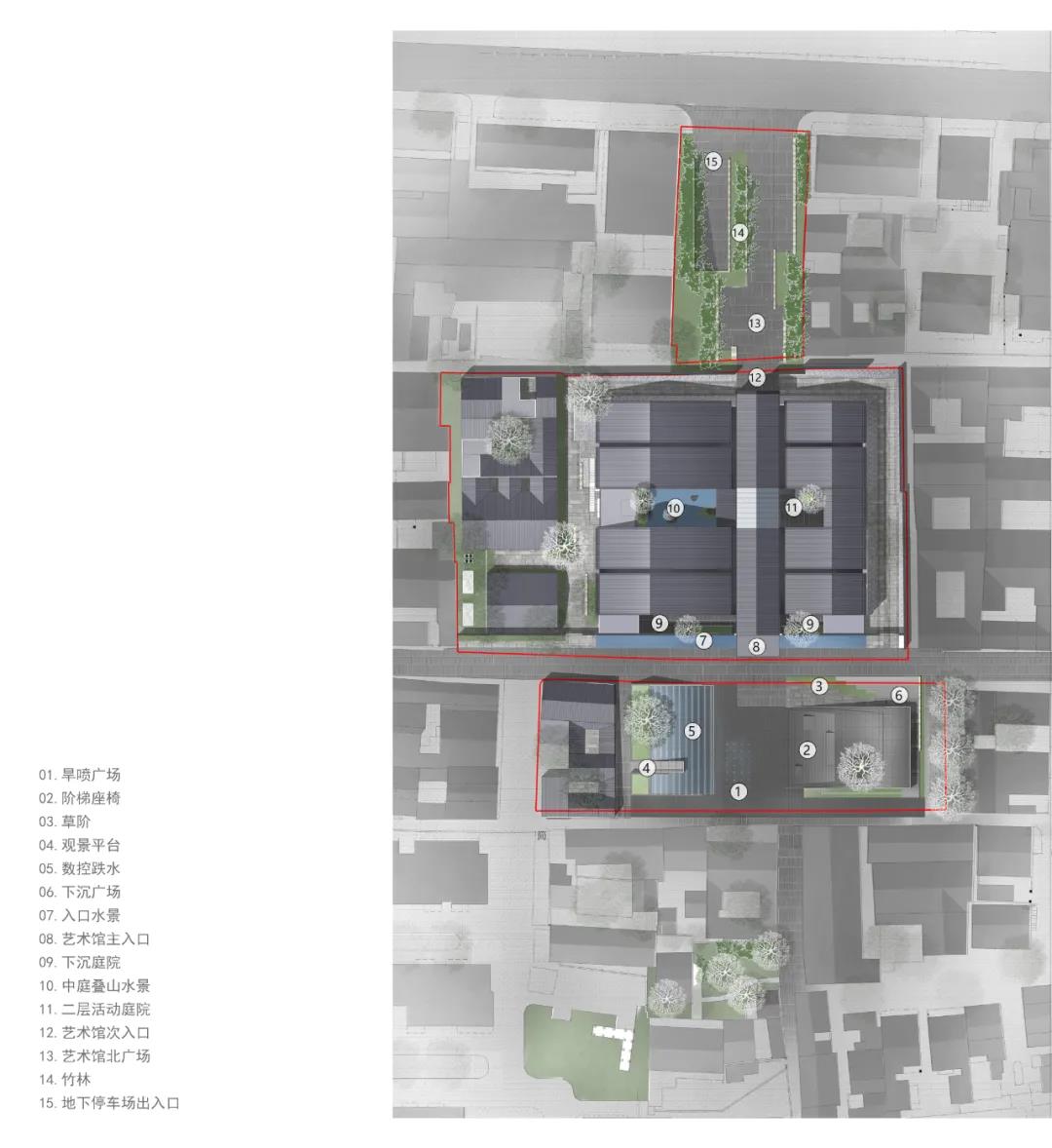
总平面图
Site Plan

一层平面图
First Floor Plan

二层平面图
Second Floor Plan
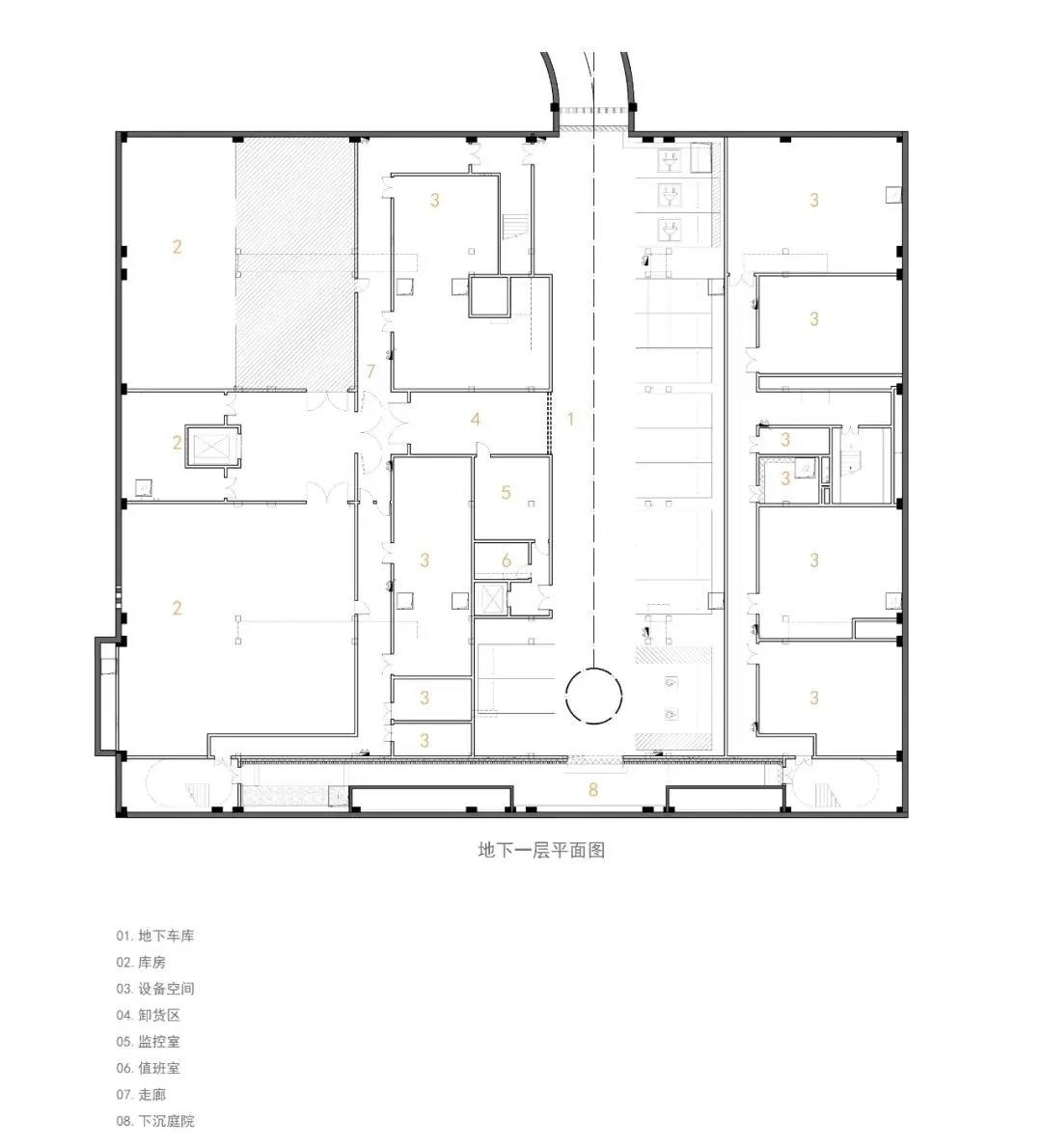
地下一层平面图
B1 Floor Plan
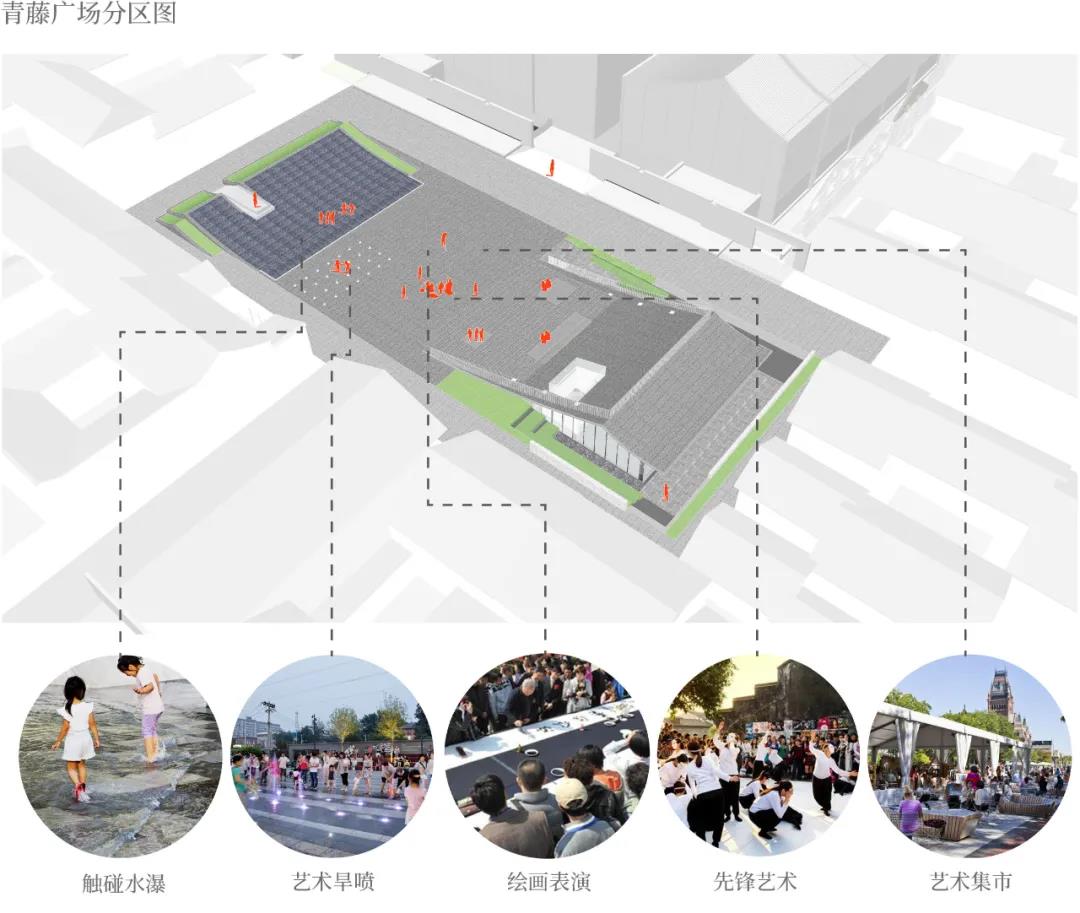
青藤广场分区图
Segmentation Map of Qingteng Square

青藤广场剖面图
Section of Qingteng Square
青藤广场剖面图
Section of Qingteng Square

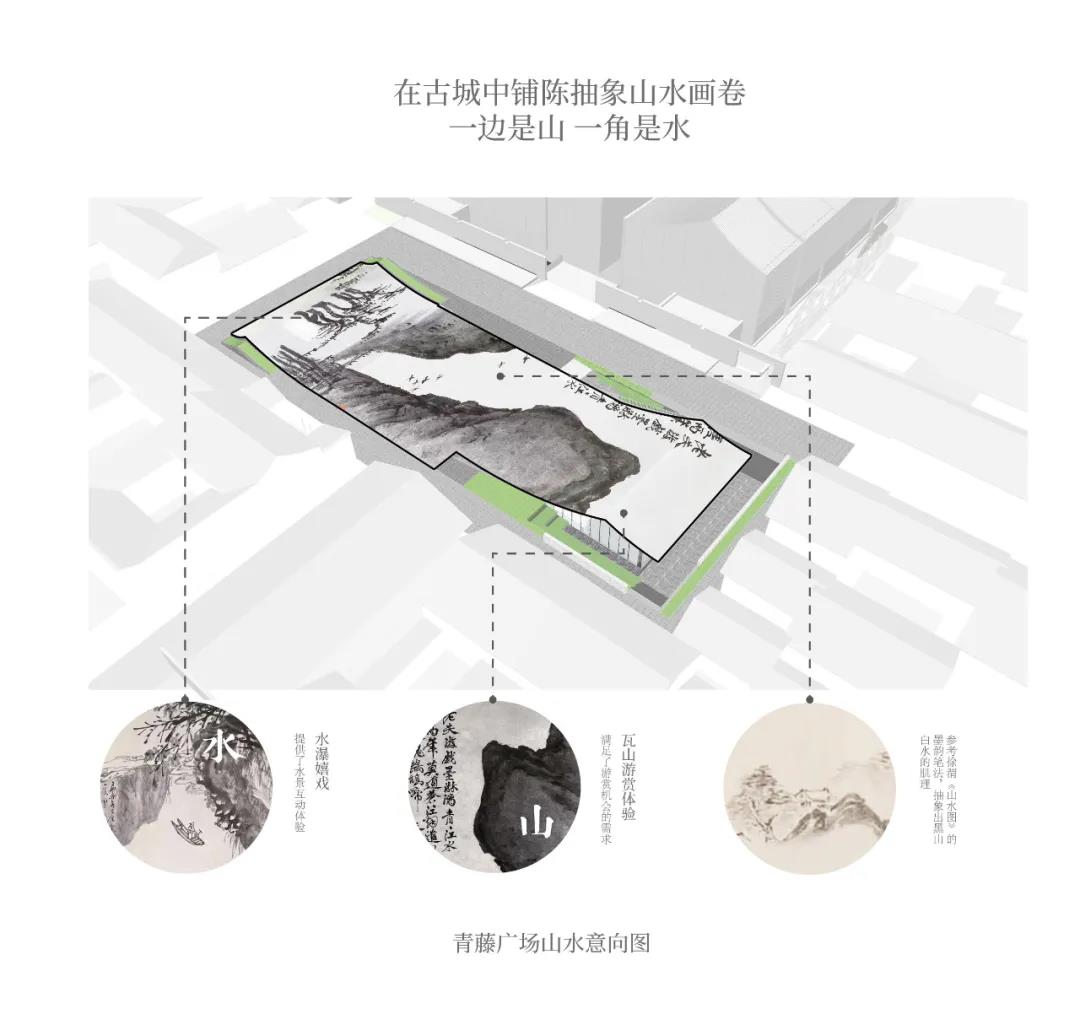
青藤广场山水意向图
Landscape Intention of Qingteng Square
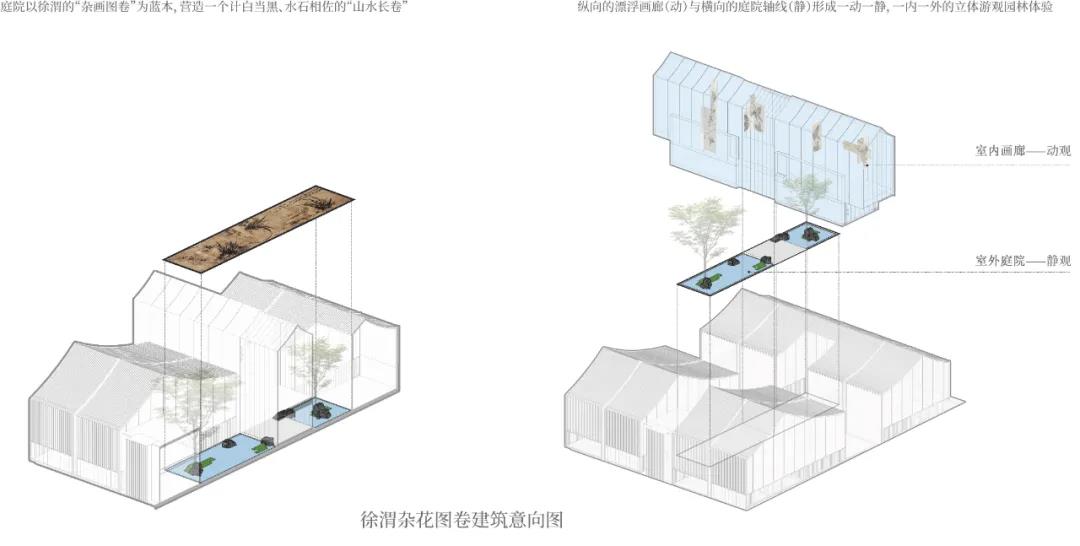
徐渭杂花图卷建筑意向图
Architectural Intention of Xu Wei’s Miscellaneous Volume
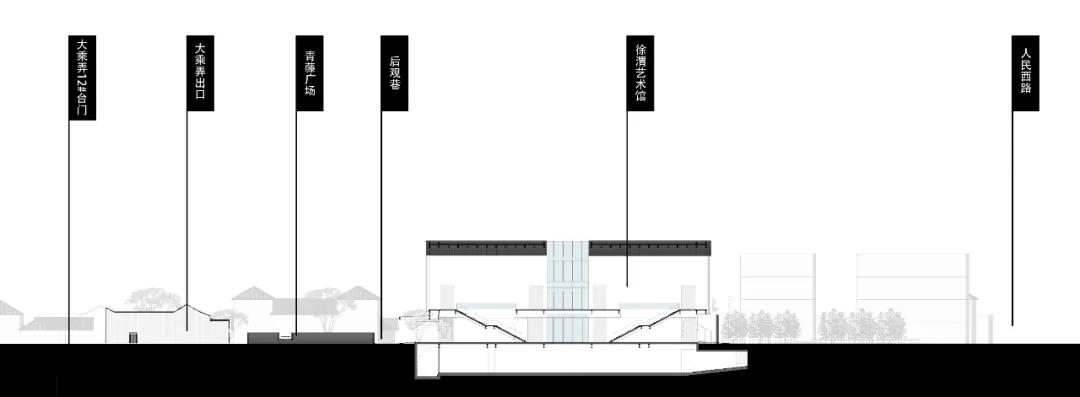
剖切面分析
Section Analysis
完整项目信息
项目类型:建筑建筑
事务所/公司/机构/单位:浙江大学建筑设计研究院
ACRC公司所在地:浙江,杭州
项目地址: 浙江省绍兴市越城区后观巷33号
建成状态:建成
设计时间(起迄年月):2020.6-2021.5
建设时间(起迄年月):2020.7-2021.5
用地面积(平方米):9854.17
建筑面积(平方米):8504.14
摄影师: 雷坛坛、贾方、章晨帆、蒋兰兰
项目参与者主创建筑师: 胡慧峰
建筑:胡慧峰、蒋兰兰、章晨帆、韩立帆、朱金运、李鹏飞
结构:张杰、陈旭、吕君锋、丁子文、沈泽平、陈晓东
水专业:易家松、邵煜然暖通专业:潘大红、李咏梅
电气专业:张薇、俞良、杜枝枝
弱电专业:林华、叶敏捷、杨国忠
景观:吴维凌、王洁涛、吴敌、朱靖、敖丹丹、何颖、林腾
室内:楚冉、刘婉琳、汪军政、梅文斌
展陈:赵同庆、梁爽、陈伟、黄世琰、孙小童
照明:王小冬、赵艳秋、傅东明、冯百乐、吴旭辉
幕墙:史炯炯、王皆能、段羽壮、张杰
基坑围护:徐铨彪、曾凯
BIM设计:张顺进、任伟、严宜涛、王启波
EPC:房朝君、王青、苗赛、贝思伽、李延琦、李晨
委托方: 绍兴市文化旅游集团
施工方:浙江勤业建工集团有限公司
合作方:浙江星睿幕墙装饰工程有限公司、故宫出版社和广东集美设计工程有限公司联合体
